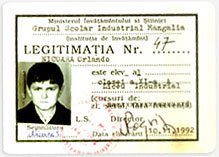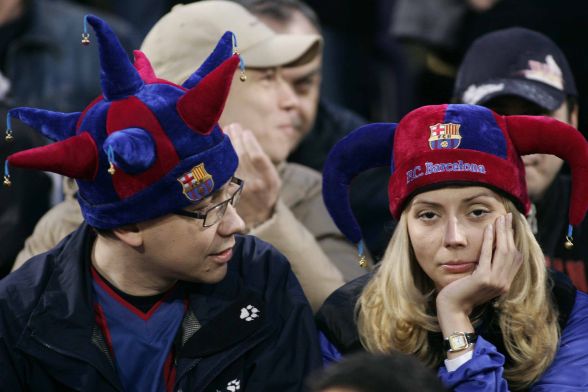Archive for the ‘Media’ Category
It’s marketing, stupid!
marți, martie 12th, 2013Cheltuielile de marketing, telefoane mobile, piata din SUA, 2012:
Samsung – $401 milioane
Apple – $333 milioane
Blackberry – $39 milioane
Nokia – $21 milioane
Sursa o voi posta maine dimineata, e un tweet, mai greu cu embedul pe iPad :)
Motivul pentru care Google se teme de Samsung
marți, martie 12th, 2013Google se teme de Samsung, nu doar pentru ca Samsung = 40% din vanzarile smartphone-urilor cu Android ci si pentru ambitiile pe care producatorul coreean le are pe entertainment si distributie continut:
David Eun once led Google and YouTube’s partnerships with media companies, turning their sometimes adversarial relationships into licensing deals. These days, he’s doing something similar, but from the hardware side of the business. As EVP of Samsung’s Open Innovation Center, Eun is charged with developing new digital content and services for a consumer electronics juggernaut that’s gunning for supremacy in everything from TVs and smartphones to refrigerators.
Onstage at D: Dive Into Media, Eun talked for the first time about Samsung’s plan to tap Silicon Valley entrepreneurs to drive its content and media business, and to turn its device portfolio into a massive content-distribution platform.
De aici
Bonus, o stire care a trecut oarecum neobservata, Google l-a angajat ca advisor pentru Motorola pe Guy Kawasaki, ex „marketing guru” la Apple:
„Kawasaki is the reason Mac enthusiasts are crazy online. He organized the first attack squads, nurtured that whole culture of guerrilla evangelism”.
Zoom. Mediafax Zoom
joi, martie 7th, 2013Deputa?ii Victor Ponta ?i Daciana Sârbu discut? în timpul meciului dintre Steaua ?i Middlesbrough, disputat la Bucure?ti, joi, 20 aprilie 2006. Echipa Steaua Bucure?ti a învins, pe teren propriu, cu scorul de 1-0 forma?ia Middlesbrough. ( Andrei Pungovschi / Mediafax Foto )
Mediafax Foto a lansat zilele trecute Mediafax Zoom, povesti in imagini, un subdomeniu in Mediafax.ro in care „vedetele” vor fi fotografiile realizate de echipa foto de la Mediafax Group sau partenerii nostri. Imaginea de mai sus face parte din galeria „Steaua Bucure?ti în cupele europene” (ca tot nu e peste ca guvidu si echipa ca Steaua :) ) insa va invit sa vedeti toate galeriile introduse pana acum, veti gasi macar o fotografie care sa va placa. Multumiri colegilor care au lucrat la proiect, Marius, Irinel, Cosmin, Mugur, Andrei, Adu.
Doua despre separarea Time Inc.
joi, martie 7th, 2013Doua despre stirea noptii, Time Warner a decis, pe modelul AOL/Time Warner Cable, sa mute intr-o companie separata tot business-ul de print. Adica Time Inc.
1. Din AOL Time Warner, adica cea mai mare fuziune ever din SUA, evaluata la 350 miliarde USD in 2000, va mai ramane, dupa separare, doar Warner.
2. Cum au evoluat veniturile/profitul Time Inc:
2002: Venituri 5.4 miliarde USD, profit 881 milioane USD
2007: Venituri 4.955 miliarde USD, profit 907 milioane USD
2012: Venituri 3.436 miliarde USD, profit 420 milioane USD
50% din publicitate va fi online in 5 ani
miercuri, martie 6th, 2013Asa zice Nikesh Arora, chief business officer Google:
“There’s currently about $800 billion in the global advertising market today. That’s a very large number, but online advertising accounts for less than $100 billion of that number. There is a reasonable probability that over 50 percent of advertising goes online in the next five years.”
De aici
Facebook ad network
vineri, martie 1st, 2013In mai 2007, Microsoft, dupa ce a ratat DoubleClickul-ul (cumparat de Google), face o miscare „aproape” disperata, plateste 6 miliarde USD (adica dublu cat a platit Google pe DBCK) pentru aQuantive, adica Atlas adserving, Avenue A Razorfish si Drivepm. Intre timp, pentru ca Microsoft nu stie sa opereze o agentie de publicitate, chiar si interactiva, acum 3 ani, Razorfish a fost preluat de Publicis intr-un deal cash and shares de +500 milioane USD, Drivepm a fost integrat in Microsoft Media Network, iar Atlas a fost cumparat de Facebook pentru o suma ce se speculeaza ca a fost in jurul la 100 milioane USD.
Stirea nu este insa ca Microsoft a vandut, cu 10% din cat a platit, doua din cele trei businessuri pe care a platit 6 miliarde USD, ci ca Atlas integrat in facebook = un concurent pentru Google AdSense (cate site-uri au azi toolurile de like si fans integrate?) + posibilitatea de a avea rapoarte mult mai detaliate despre ceea ce se intampla cu reclamele pe facebook. Si ca modelul de business al facebook-ului se bazeaza mult spre foarte mult pe advertising.
Facebook is very focused on proving the worth of the data it sits on as well as the effectiveness of its ads. Owning an ad server would allow big advertisers and agencies to connect directly to Facebook to better measure the effectiveness of their campaigns.
Achizitia Doubleclick a schimbat complet paradigma la Google, de la softuri care stergeau cookie-urile si noi nu vom folosi niciodata bannere la campanii pentru sustinerea importantei display-ului si formate speciale. Si s-a dovedit una dintre cele mai inspirate achizitii facute de Google pana acum pentru ca le-a facilitat intrarea pe o piata mare si cu potential mare, cea a display-ului.
Publicitatea pe Avocatnet.ro va fi vanduta de Mediafax Group
joi, februarie 28th, 2013Incepand cu 1 martie, adica de maine, Mediafax Group va reprezenta site-ul Avocatnet.ro pe vanzarea de publicitate. Ceea ce inseamna ca pe sectiunea business (sau Economic & Financiar cum apare in SATI), Mediafax Group va avea, cu cele 4 siteuri pe care le reprezinta, ZF, Avocatnet, BusinessMagazin si CursValutar.ro, 26% din piata actuala la nivel de unici duplicati, 28% la nivel de vizite si 36% la nivel de afisari!, totul conform cifrelor din luna ianuarie. Asta din punct de vedere statistic, in realitate avem numarul 1 si 2 din categorie, iar in curand, o data cu cresterea bmag.ro, vom avea numarul 1, 2 si 3.
70 de secunde vs 25 de minute
marți, februarie 26th, 2013Sau cum devenim de la o zi la alta mai superficiali. Sau mai selectivi. Alegeti voi.
In 2008 Jeff Zucker, CEO of NBC at the time, made famous a line about “broadcast dollars” becoming “digital pennies,” a quip that captures the phenomenon by which advertisers pay a fraction of traditional-media CPMs for the website version of the same content. A few years later Google chief economist Hal Varian wrote a post that touched on similar issues and their relationship to the newspaper business. In 2010, when he wrote it, he observed that while the Internet has been a boon to news consumption — more people read news, and more of us do so everyday — there’s one aspect of our news-reading that’s gone very much in the wrong direction: The amount of attention we pay to news when we read it online. We spend only 70 seconds per day reading news online; back when we got our news in a paper format, it was 25 minutes per day.
If we’re only fractionally engaged with online content, then, it’s logical that advertisers value online ads at pennies on the dollar.
Part of the explanation for our digital distractedness is the wealth — overabundance?! — of content choices online. But the more significant explanation, I think, is that digital content is inevitably archived and easily searchable. We graze and skim through content now because we know we can go back later, when we will have more time to actually pay attention. Tag it #longreads, push it to Instapaper, or leave open another tab in your browser. Then you can go back later and give it a really thorough read.
Intreg contextul, unul surprinzator, aici
O poveste cu masini, pr, jurnalism si semne de intrebare
luni, februarie 18th, 2013O poveste despre disputa dintre Tesla, producatorul de masini electrice, si New York Times:
1. Tesla vs. The New York Times: Everyone’s A Media Company Now
Even a few years ago, something like this probably would have required finding a rival newspaper — the Wall Street Journal, perhaps — to collaborate on a takedown. Or maybe an expensive full-page ad campaign in the top five papers, which would have looked defensive and seemed less convincing.
But now that every smart company has a regularly updated blog, Elon Musk has 136,000 Twitter followers, etc., brands can speak for themselves very powerfully. And if the tone is right, they don’t even look lame: Tesla actually looks pretty great right now*. The balance of power has shifted.
2.
Corporate PRs everywhere are reading @elonmusk ‘s NYT take down and thinking ‘hmm’
— emily bell (@emilybell) February 14, 2013
3. Tesla, the New York Times and the levelling of the media playing field
In a very real sense, everyone is a media entity of some kind now. That doesn’t mean someone with a few hundred followers on Twitter is the equivalent of the New York Times, but it does mean that a large corporation like Tesla Motors is on a much more level playing field with the newspaper than it would ever have been before. In the past, if Tesla didn’t like a review, it could a) call and complain, b) put out a press release and try to get a competitor interested in a story c) launch an expensive lawsuit (which Musk has also done in the past).
And what about society, or journalism in general — is it better off when this happens? There are two ways of looking at that question too: if you want to make it easier to figure out who is right and who is wrong, the current state of affairs isn’t going to help. The only thing that becomes obvious from the back-and-forth between Tesla and the New York Times is that it’s very difficult, and perhaps even impossible, to tell who is right on specific points. Some political topics are also arguably getting harder to understand rather than easier.
4. Tesla Owners Hit the Road to Prove Long-Distance Can Be Done
A group of Tesla Model S owners, charged up over a recent New York Times column that challenged the reliability of the electric vehicle, hit the road this weekend to replicate the same drive the Times reporter made.
Povestea unei campanii
marți, februarie 12th, 2013Povestea campaniei gandul & gmp o gasiti aici, mai jos aveti finalul, macheta aparuta ieri, pe o pagina intreaga, in The Guardian.



